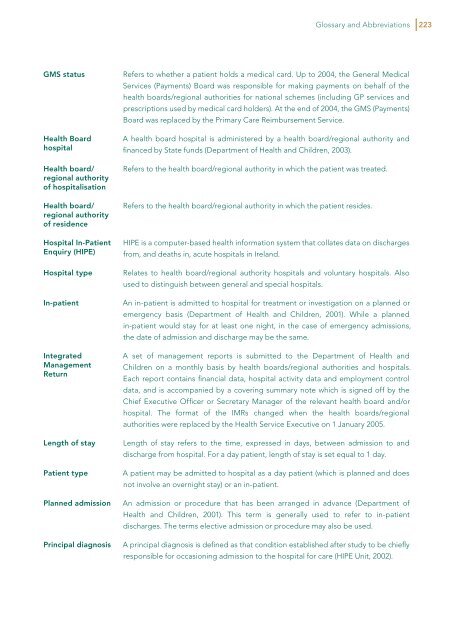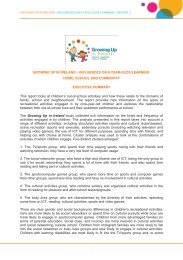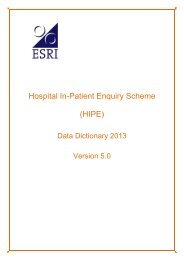Glossary and Abbreviations - ESRI
Glossary and Abbreviations - ESRI
Glossary and Abbreviations - ESRI
You also want an ePaper? Increase the reach of your titles
YUMPU automatically turns print PDFs into web optimized ePapers that Google loves.
<strong>Glossary</strong> <strong>and</strong> <strong>Abbreviations</strong><br />
223<br />
GMS status<br />
Health Board<br />
hospital<br />
Health board/<br />
regional authority<br />
of hospitalisation<br />
Health board/<br />
regional authority<br />
of residence<br />
Hospital In-Patient<br />
Enquiry (HIPE)<br />
Hospital type<br />
In-patient<br />
Integrated<br />
Management<br />
Return<br />
Length of stay<br />
Patient type<br />
Planned admission<br />
Principal diagnosis<br />
Refers to whether a patient holds a medical card. Up to 2004, the General Medical<br />
Services (Payments) Board was responsible for making payments on behalf of the<br />
health boards/regional authorities for national schemes (including GP services <strong>and</strong><br />
prescriptions used by medical card holders). At the end of 2004, the GMS (Payments)<br />
Board was replaced by the Primary Care Reimbursement Service.<br />
A health board hospital is administered by a health board/regional authority <strong>and</strong><br />
financed by State funds (Department of Health <strong>and</strong> Children, 2003).<br />
Refers to the health board/regional authority in which the patient was treated.<br />
Refers to the health board/regional authority in which the patient resides.<br />
HIPE is a computer-based health information system that collates data on discharges<br />
from, <strong>and</strong> deaths in, acute hospitals in Irel<strong>and</strong>.<br />
Relates to health board/regional authority hospitals <strong>and</strong> voluntary hospitals. Also<br />
used to distinguish between general <strong>and</strong> special hospitals.<br />
An in-patient is admitted to hospital for treatment or investigation on a planned or<br />
emergency basis (Department of Health <strong>and</strong> Children, 2001). While a planned<br />
in-patient would stay for at least one night, in the case of emergency admissions,<br />
the date of admission <strong>and</strong> discharge may be the same.<br />
A set of management reports is submitted to the Department of Health <strong>and</strong><br />
Children on a monthly basis by health boards/regional authorities <strong>and</strong> hospitals.<br />
Each report contains financial data, hospital activity data <strong>and</strong> employment control<br />
data, <strong>and</strong> is accompanied by a covering summary note which is signed off by the<br />
Chief Executive Officer or Secretary Manager of the relevant health board <strong>and</strong>/or<br />
hospital. The format of the IMRs changed when the health boards/regional<br />
authorities were replaced by the Health Service Executive on 1 January 2005.<br />
Length of stay refers to the time, expressed in days, between admission to <strong>and</strong><br />
discharge from hospital. For a day patient, length of stay is set equal to 1 day.<br />
A patient may be admitted to hospital as a day patient (which is planned <strong>and</strong> does<br />
not involve an overnight stay) or an in-patient.<br />
An admission or procedure that has been arranged in advance (Department of<br />
Health <strong>and</strong> Children, 2001). This term is generally used to refer to in-patient<br />
discharges. The terms elective admission or procedure may also be used.<br />
A principal diagnosis is defined as that condition established after study to be chiefly<br />
responsible for occasioning admission to the hospital for care (HIPE Unit, 2002).
















